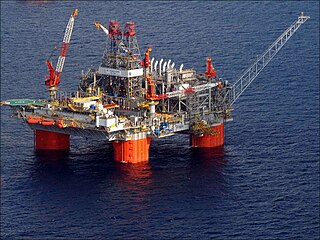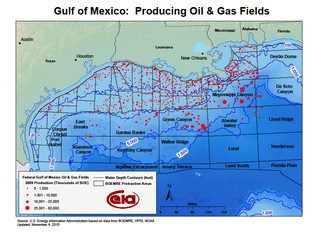
Thunder Horse oil field is a large offshore deepwater oil field in the Gulf of Mexico, around 150 miles (240 km) southeast of New Orleans, Louisiana. Large new oil discoveries within it were announced in early 2019.

APA Corporation is the holding company for Apache Corporation, an American company engaged in hydrocarbon exploration. It is organized in Delaware and headquartered in Houston. The company is ranked 431st on the Fortune 500.

Big Oil is a name sometimes used to describe the world's six or seven largest publicly traded and investor-owned oil and gas companies, also known as supermajors. The term, particularly in the United States, emphasizes their economic power and influence on politics. Big Oil is often associated with the fossil fuels lobby and also used to refer to the industry as a whole in a pejorative or derogatory manner.

QatarEnergy, formerly Qatar Petroleum (QP), is a state owned petroleum company of Qatar. The company operates all oil and gas activities in Qatar, including exploration, production, refining, transport, and storage. The President & CEO is Saad Sherida al-Kaabi, Minister of State for Energy Affairs. The company's operations are directly linked with state planning agencies, regulatory authorities, and policy making bodies. Together, revenues from oil and natural gas amount to 60% of the country's GDP. As of 2018 it was the third largest oil company in the world by oil and gas reserves. In 2022, the company had total revenues of US$52bn, a net income of US42.4bn, and total assets of US$162bn. In 2021, QatarEnergy was the fifth largest gas company in the world.

Deepwater Horizon was an ultra-deepwater, dynamically positioned, semi-submersible offshore drilling rig owned by Transocean and operated by the BP company. On 20 April 2010, while drilling in the Gulf of Mexico at the Macondo Prospect, a blowout caused an explosion on the rig that killed 11 crewmen and ignited a fireball visible from 40 miles (64 km) away. The fire was inextinguishable and, two days later, on April 22, the Horizon collapsed, leaving the well gushing at the seabed and becoming the largest marine oil spill in history.
This page summarizes projects that brought more than 20,000 barrels per day (3,200 m3/d) of new liquid fuel capacity to market with the first production of fuel beginning in 2007. This is part of the Wikipedia summary of Oil Megaprojects.
This page summarizes projects that brought more than 20,000 barrels per day (3,200 m3/d) of new liquid fuel capacity to market with the first production of fuel beginning in 2008. This is part of the Wikipedia summary of Oil Megaprojects.
Following is a list of Oil megaprojects in the year 2011, projects that propose to bring more than 20,000 barrels per day (3,200 m3/d) of new liquid fuel capacity to market with the first production of fuel. This is part of the Wikipedia summary of Oil Megaprojects.
This page summarizes projects that propose to bring more than 20,000 barrels per day (3,200 m3/d) of new liquid fuel capacity to market, with the first production of fuel beginning in 2012. This is part of the Wikipedia summary of oil megaprojects.
This page summarizes projects that propose to bring more than 20,000 barrels per day (3,200 m3/d) of new liquid fuel capacity to market, with the first production of fuel beginning in 2013. This is part of the Wikipedia summary of oil megaprojects.
This page summarizes projects that propose to bring more than 20,000 barrels per day (3,200 m3/d) of new liquid fuel capacity to market with the first production of fuel beginning in 2014. This is part of the Wikipedia summary of Oil Megaprojects.
Green Canyon is an area in the Gulf of Mexico that is rich in oil fields and under the jurisdiction of the Bureau of Ocean Energy Management. Among other oil fields Green Canyon consist of Atlantis operated by BP, Marco Polo and K2 operated by Anadarko Petroleum, Manatee operated by Shell, Shenzi operated by BHP, Droshky operated by Marathon Oil, and Tahiti operated by Chevron.

The Mississippi Canyon is an undersea canyon, part of the Mississippi Submarine Valley in the North-central Gulf of Mexico, south of Louisiana. According to the U.S. Geological Survey GLORIA Mapping Program, it is the dominant feature of the north-central Gulf of Mexico. According to GCAGS Transactions, it has an average width of 8 kilometres (5.0 mi), and a length of 120 kilometres (75 mi). The US Minerals Management Service (MMS) applies the name Mississippi Canyon to numbered federal oil and gas lease blocks over a large offshore area centered on, but mostly outside, the submarine canyon.

Offshore drilling for oil and gas on the Atlantic coast of the United States took place from 1947 to the early 1980s. Oil companies drilled five wells in Atlantic Florida state waters and 51 exploratory wells on federal leases on the outer continental shelf of the Atlantic coast. None of the wells were completed as producing wells. All the leases have now reverted to the government.

The Tiber Oil Field is a deepwater offshore oil field located in the Keathley Canyon block 102 of the United States sector of the Gulf of Mexico. The deepwater field was discovered in September 2009 and it is operated by BP. Described as a "giant" find, it is estimated to contain 4 to 6 billion barrels of oil in place. Although BP states it is too early to be sure of the size – a "huge" field is usually considered to contain 250 million barrels. It required the drilling of a 10,685 m (35,056 ft) deep well under 1,260 m (4,130 ft) of water, making it one of the deepest wells ever drilled at the time of discovery.
Iara oil field is a large ultra-deepwater pre-salt oil field located in the Santos Basin, 230 km (140 mi) off the coast of Rio de Janeiro, Brazil, north of Tupi oil field. It covers an area of nearly 300 km2 (120 sq mi).

Thunder HorsePDQ is a BP plc and ExxonMobil joint venture semi-submersible oil platform on location over the Mississippi Canyon Thunder Horse oil field, in deepwater Gulf of Mexico, 150 miles (240 km) southeast of New Orleans, moored in waters of 1,840 metres (6,040 ft). The "PDQ" identifies the platform as being a Production and oil Drilling facility with crew Quarters.
The Kaskida Oil Field is an offshore oil field located in the Keathley Canyon block 292 of the United States sector of the Gulf of Mexico, 250 miles (400 km) south-west of New Orleans, Louisiana. The field is operated by BP, and owned by BP (100%).

The pre-salt layer is a diachronous series of geological formations on the continental shelves of extensional basins formed after the break-up of Gondwana, characterized by the deposition of thick layers of evaporites, mostly salt. Some of the petroleum that was generated from sediments in the pre-salt layer has not migrated upward to the post-salt layers above due to salt domes. This is especially common off the coast of Africa and Brazil. Total pre-salt oil reserves are thought to be a significant fraction of the world's oil reserves. According to Brazilian oil and gas company Petrobras, the oil and natural gas reserves lie below an approximately 2,000 metres (6,600 ft) thick layer of salt, which in turn is beneath more than 2,000 metres (6,600 ft) of post-salt sediments in places, which in turn is under water depths between 2,000 and 3,000 metres in the South Atlantic. Because of this, drilling through the rock and salt to extract the pre-salt oil and gas is very expensive.
Appaloosa is an offshore oil field located in the Mississippi Canyon blocks 459, 460, 503, and 504 of the United States sector of the Gulf of Mexico. It is a part of the Greater Longhorn area. The field is developed by the Italian energy company Eni.









